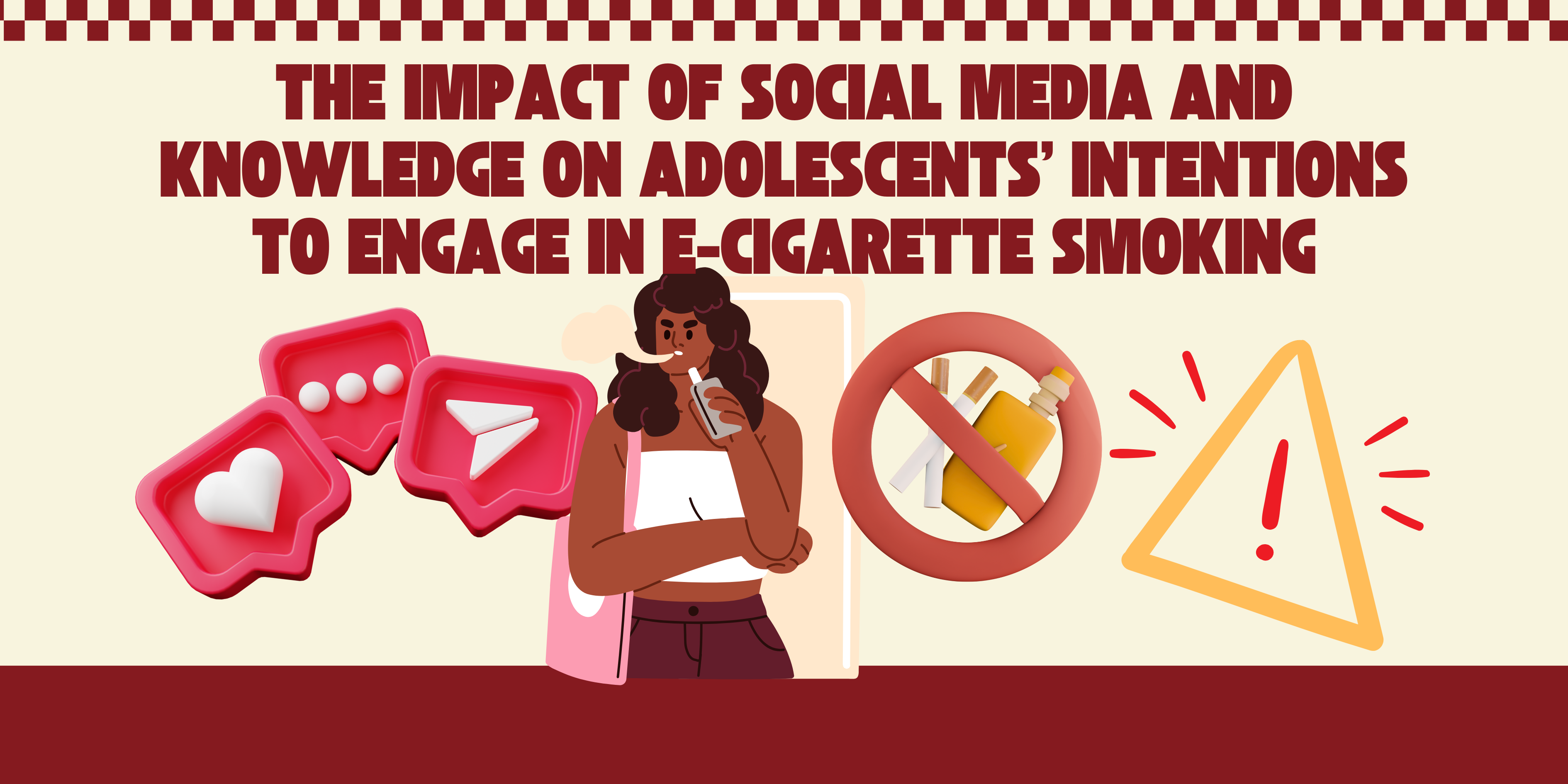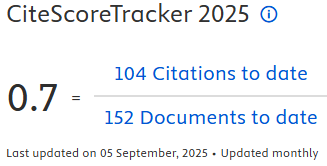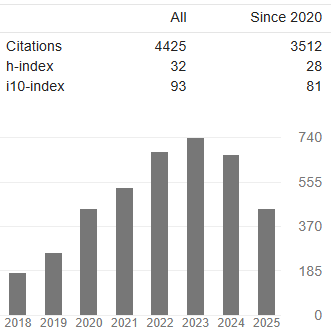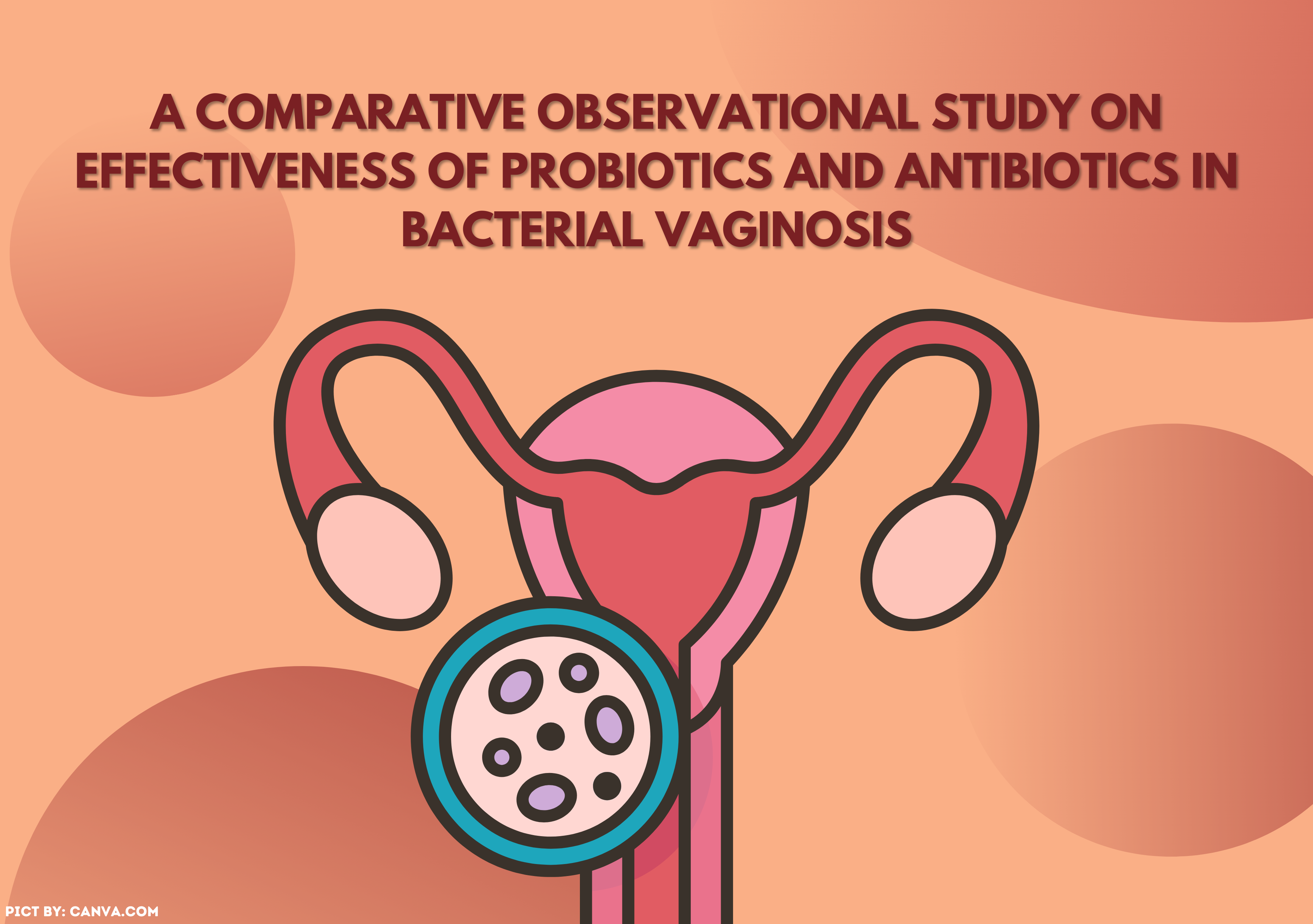THE IMPACT OF SOCIAL MEDIA AND KNOWLEDGE ON ADOLESCENTS' INTENTIONS TO ENGAGE IN E-CIGARETTE SMOKING

Downloads
Introduction: The global prevalence of e-cigarette use among adolescents (11.3%) is increasing, primarily driven by exposure to promotional content on social media platforms. Aims: This study aimed to examine how exposure to e-cigarette content, content type, e-cigarette-related activity within the content, and knowledge about e-cigarettes influence adolescents’ intention to use e-cigarettes. Method: This survey-based study was conducted in Surakarta, Central Java, in November 2024. A total of 260 junior and senior high school students were selected through stratified random sampling. Data were collected using a structured questionnaire, and logistic regression analysis was applied to evaluate the relationships between variables. Results: The analysis indicated that exposure to e-cigarette content significantly increased the intention to use e-cigarettes (p < 0.001). In contrast, higher levels of knowledge about e-cigarettes were significantly associated with a lower intention to use them (p = 0.020). However, neither the type of content nor the presence of e-cigarette-related activity within the content showed a significant association with use intention (p = 0.501 and p = 0.162, respectively). The logistic regression model accounted for 25% to 34% of the variance in e-cigarette use intention, suggesting a moderate explanatory power. Conclusion: These findings underscore the significant influence of e-cigarette content exposure and adolescents’ knowledge levels on their intention to use e-cigarettes. While exposure increases the likelihood of use, adequate knowledge appears to reduce it. Therefore, reducing adolescents’ exposure to e-cigarette content and improving their awareness of the associated health risks may serve as effective strategies to prevent e-cigarette initiation.
Achak, D., Azizi, A., El-Ammari, A., Marfak, I. Y., Saad, E., Nejjari, C., Hilali, A., Peltzer, K., & Marfak, A. (2024). The health behaviors differences among male and female school-age adolescents in the Middle East and North Africa region countries: a meta-analysis of the Global School-based Student Health Survey data. Frontiers in Public Health, 12. https://doi.org/10.3389/fpubh.2024.1448386
Azzahra, K., & Andriyani. (2022). Factors related to smoking behavior in high school adolescents in al-hasra in 2022. Muhammadiyah International Public Health and Medicine Conference, 2(1), 248–258. https://doi.org/10.61811/miphmp.v1i2.253
Bagnall, C. L., Fox, C. L., Skipper, Y., & Oldfield, J. (2021). Evaluating a universal emotional-centred intervention to improve children’s emotional well-being over primary-secondary school transition. Advances in Educational Research and Evaluation, 2(1), 113–126. https://doi.org/10.25082/AERE.2021.01.003
Bahl, D., Bassi, S., Thapliyal, N., Sinha, P., Arora, M., & Gill, M. S. (2023). Tobacco-related content on social networking sites: evidence from a youth-led campaign in India. Journal of Global Health Reports, 7. https://doi.org/10.29392/001c.85126
Bigwanto, M., Arumsari, I., & Fauzi, R. (2023). The portrayal of electronic cigarettes in Indonesia: a content analysis of news media. BMC Public Health, 23(1), 1–10. https://doi.org/10.1186/s12889-022-14886-z
Chen-Sankey, J., Weiger, C., La Capria, K., Vassey, J., Jeong, M., Phan, L., Unger, J. B., Allem, J. P., Berg, C. J., & Choi, K. (2024). Young adults’ visual attention to features of social media marketing for disposable e‐cigarettes and associated perceptions. Addiction. https://doi.org/10.1111/add.16586
Cho, H., Li, W., Shen, L., & Cannon, J. (2019). Mechanisms of Social Media Effects on Attitudes Toward E-Cigarette Use: Motivations, Mediators, and Moderators in a National Survey of Adolescents. Journal of Medical Internet Research, 21(6). https://doi.org/10.2196/14303
Cohen, J., Cohen, P., West, S. G., & Aiken, L. S. (2013). Applied Multiple Regression/Correlation Analysis for the Behavioral Sciences, Third Edition. Applied Multiple Regression/Correlation Analysis for the Behavioral Sciences, Third Edition, 1–704. https://doi.org/10.4324/9780203774441
Donaldson, S. I., Beard, T. A., Chen-Sankey, J. C., Ganz, O., Wackowski, O., & Allem, J.-P. (2024). Recognition of online e-cigarette marketing and e-cigarette-related attitudes and behaviors among young adults. Nicotine & Tobacco Research. https://doi.org/10.1093/ntr/ntae167
Donaldson, S. I., Dormanesh, A., Perez, C., Majmundar, A., & Allem, J. P. (2022). Peer Pressure and Social Media Impact of Smoking/Vaping and its Neuroscience Correlation. Rising Researchers, 176(Fall 2024), 878–885. https://doi.org/10.1001/jamapediatrics.2022.2223
Easterbrook, M. J., & Hadden, I. R. (2021). Tackling Educational Inequalities with Social Psychology: Identities, Contexts, and Interventions. Social Issues and Policy Review, 15(1), 180–236. https://doi.org/10.1111/sipr.12070
FDA. (2024). Results from the Annual National Youth Tobacco Survey.
Gonzales, A. jauregui, & Grover, I. (2023). Influencer Endorsements of E-Cigarette Brands on Instagram. In Jonkoping university (Issue May).
Hartono, R., Yan, C., Chen, Y., Ma, B., Deng, Y., Sun, Y., Li, P., Dao, Y., & Deng, R. (2024). Knowledge, attitude, and practice of e-cigarette use among undergraduate students: A comparative study between China and Indonesia. Tobacco Induced Diseases, 22(July), 1–12. https://doi.org/10.18332/tid/190636
Health Development Policy Agency, Ministry of Health, Republic of Indonesia. (2023). Indonesia Health Survey 2023 in Figures.
Kunzler, A. M., Helmreich, I., Chmitorz, A., König, J., Binder, H., Wessa, M., & Lieb, K. (2020). Psychological interventions to foster resilience in healthcare professionals. The Cochrane Database of Systematic Reviews, 2020(7), CD012527. https://doi.org/10.1002/14651858.CD012527.pub2
Lee, J., Krishnan-Sarin, S., & Kong, G. (2023). Social Media Use and Subsequent E-Cigarette Susceptibility, Initiation, and Continued Use Among US Adolescents. Preventing Chronic Disease, 20, E78. https://doi.org/10.5888/pcd20.220415
Lee, J., Ouellette, R. R., Morean, M. E., & Kong, G. (2024). Adolescents and Young Adults Use of Social Media and Following of e-Cigarette Influencers. Substance Use & Misuse, 59(9), 1–7. https://doi.org/10.1080/10826084.2024.2352620
Lewis-Thames, M. W., Langston, M. E., Fuzzell, L., Khan, S., Moore, J. X., & Han, Y. (2020). Rural-urban differences e-cigarette ever use, the perception of harm, and e-cigarette information seeking behaviors among U.S. adults in a nationally representative study. Preventive Medicine, 130. https://doi.org/10.1016/j.ypmed.2019.105898
Lin, M., Chu, M., Li, X., Ma, H., Fang, Z., Mao, L., Wang, P., Chen, T., & Chiang, Y. C. (2023). Factors influencing adolescent experimental and current smoking behaviors based on social cognitive theory: A cross-sectional study in Xiamen. Frontiers in Public Health, 11, 1093264. https://doi.org/10.3389/fpubh.2023.1093264
Lipkus, I., & Sanders, C. (2021). A Pilot Study Assessing Reactions to Educational Videos on Harm of Waterpipe among Young Adults Susceptible to Waterpipe Tobacco Smoking. Journal of Health Communication, 26(11), 1–10. https://doi.org/10.1080/10810730.2021.2000522
McKee, S. A., & Weinberger, A. H. (2015). Innovations in Translational Sex and Gender-Sensitive Tobacco Research. Nicotine & Tobacco Research, 17(4), 379–381. https://doi.org/10.1093/ntr/ntu335
Moskell, C., & Turner, R. W. (2021). Can a YouTube video lead to changes in environmental beliefs, attitudes, norms, and intended behavior? Journal of Environmental Studies and Sciences, 12(1), 1–8. https://doi.org/10.1007/s13412-021-00719-9
Peighambari, S., Hassanzadeh, R., & Khoshfar, G. (2020). The relationship between media consumption and Internet addiction with an emphasis on the role of gender. International Journal of Schooling, 2(3), 47–58.
Pettigrew, S., Santos, J. A., Pinho-Gomes, A. C., Li, Y., & Jones, A. (2023). Exposure to e-cigarette advertising and young people’s use of e-cigarettes: A four-country study. Tobacco Induced Diseases, 21(October), 1–8. https://doi.org/10.18332/tid/172414
Picoito, J., Santos, C., Loureiro, I., Aguiar, P., & Nunes, C. (2019). Gender-specific substance use patterns and associations with individual, family, peer, and school factors in 15-year-old Portuguese adolescents: a latent class regression analysis. Child and Adolescent Psychiatry and Mental Health, 13(1), 21. https://doi.org/10.1186/s13034-019-0281-4
Rutherford, B. N., Lim, C. C. W., Cheng, B., Sun, T., Vu, G. T., Johnson, B., Daniel Paul Ashley, Chung, J., Huang, S., Leung, J., Stjepanović, D., Connor, J. P., & Chan, G. C. K. (2023). Viral Vaping: A systematic review and meta analysis of e-cigarette and Tobacco-Related social media content and its influence on youth behaviours and attitudes. Addictive Behaviors, 147, 107828–107828. https://doi.org/10.1016/j.addbeh.2023.107828
Salari, N., Rahimi, S., Darvishi, N., Abdolmaleki, A., & Mohammadi, M. (2024). The global prevalence of E-cigarettes in youth: a comprehensive systematic review and meta-analysis. Public Health in Practice, 7. https://doi.org/10.1016/j.puhip.2024.100506
Sarkees, A. N., & Issa, S. A. (2024). Smoking Behaviors and Related Factors Among Secondary School Students in Duhok City. Iraqi Journal of Pharmacy, 21(1), 36–44. https://doi.org/10.33899/iraqij.p.2024.145584.1077
Short, M., & Cole, A. G. (2021). Factors associated with e-cigarette escalation among high school students: A review of the literature. International Journal of Environmental Research and Public Health, 18(19). https://doi.org/10.3390/ijerph181910067
Sianturi, N. P., Diarang, A., Loho, H., & Rasjid, A. (2024). Peran psikologi perkembangan dalam dunia pendidikan anak SMP. PADAMARA: Jurnal Psikologi dan Sosial Budaya, 1(2), 42–52. https://doi.org/10.70420/8076et70
Smith, M. J., Buckton, C., Patterson, C., & Hilton, S. (2023). User-generated content and influencer marketing involving e-cigarettes on social media: a scoping review and content analysis of YouTube and Instagram. BMC Public Health, 23(1). https://doi.org/10.1186/s12889-023-15389-1
Smith, M. J., & Hilton, S. (2023). Youth’s exposure to and engagement with e-cigarette marketing on social media: a UK focus group study. BMJ Open, 13(8), e071270. https://doi.org/10.1136/bmjopen-2022-071270
Solomon, A. (2020). Gender, women, and the future of tobacco control. Drugs and Alcohol Today, 20(3), 249–262. https://doi.org/10.1108/DAT-02-2020-0005
Statistics Indonesia, Central Java Province. (2024). Percentage of Population Aged 15 Years and Over Who Smoked in the Past Month by Regency/Municipality and Age Group in Central Java Province.
Susanto, A., Hartono, H., Nurhaeni, I. D. A., & Kartono, D. T. (2020). The Schools Role in Preventing Smoking Behavior of Junior High School Students in Tegal City. Proceedings of the 1st International Conference on Science, Health, Economics, Education and Technology (ICoSHEET 2019), 140–144. https://doi.org/10.2991/ahsr.k.200723.035
Susanto, A., Hartono, H., Nurhaeni, I. D. A., & Kartono, D. T. (2023). The barriers to prevent smoking behavior of junior high school students: A qualitative study. Improving Health for Better Future Life: Strengthening from Basic Science to Clinical Research, 265–271. https://doi.org/10.1201/9781032693408-44
Tavakol, M., & Dennick, R. (2011). Making sense of Cronbach’s alpha. International Journal of Medical Education, 2, 53–55. https://doi.org/10.5116/ijme.4dfb.8dfd
Vassey, J., Vogel, E. A., & Unger, J. B. (2024). US adolescents’ response to nicotine warning labels in influencer e-cigarette marketing social media posts: a survey-based randomised between-subject experiment. Tobacco Control. https://doi.org/10.1136/tc-2023-058534
Vogel, E. A., Barrington-Trimis, J. L., Vassey, J., Soto, D., & Unger, J. B. (2024). Young Adults’ Exposure to and Engagement With Tobacco-Related Social Media Content and Subsequent Tobacco Use. Nicotine and Tobacco Research, 26, S3–S12. https://doi.org/10.1093/ntr/ntad108
Vrinten, C., Parnham, J., Radó, M. K., Filippidis, F. T., Vamos, E., & Laverty, A. A. (2023). Associations of social media use with tobacco smoking and e-cigarettes: a national longitudinal study. The Lancet, 42. https://doi.org/10.1101/2023.06.03.23290924
West, R. (2017). Tobacco smoking: Health impact, prevalence, correlates and interventions. Psychology & Health, 32(8), 1018–1036. https://doi.org/10.1080/08870446.2017.1325890
WHO. (2021). WHO global report on trends in prevalence of tobacco use 2000-2025.
Zheng, X., Li, W., Li, R., Yang, M., & Lin, H. C. (2024). Exposure to user-generated e-cigarette content on social media associated with greater vulnerability to e-cigarette use among youth non-users. Addictive Behaviors, 156, 108061. https://doi.org/10.1016/j.addbeh.2024.108061
Copyright (c) 2025 The Indonesian Journal of Public Health

This work is licensed under a Creative Commons Attribution-NonCommercial-ShareAlike 4.0 International License.
- The authors agree to transfer the transfer copyright of the article to The Indonesian Journal of Public Health effective if and when the paper is accepted for publication.
- Authors and other parties are bound to the Creative Commons Attribution-NonCommercial-ShareAlike 4.0 International License for the published articles, legal formal aspect of journal publication accessibility refers to Creative Commons Attribution-NonCommercial-ShareAlike 4.0 International License (CC BY-NC-SA), implies that:
- Attribution ” You must give appropriate credit, provide a link to the license, and indicate if changes were made. You may do so in any reasonable manner, but not in any way that suggests the licensor endorses you or your use.
- NonCommercial ” You may not use the material for commercial purposes.
- ShareAlike ” If you remix, transform, or build upon the material, you must distribute your contributions under the same license as the original.































